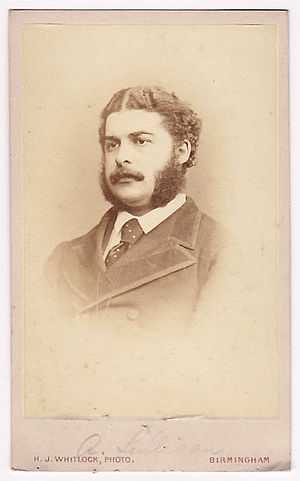Overture di Ballo

 |
Overture di Ballo
Overture di Ballo, in a military band arrangement, performed by United States Marine Band. |
| Problems playing this file? See media help. | |
The Overture di Ballo is a concert overture by Arthur Sullivan. Its first performance was in August 1870 at the Birmingham Triennial Festival, conducted by the composer. It predates all his work with W. S. Gilbert, and is his most frequently played concert work for orchestra.
Name
The title of the work as printed on the original programme was Overtura di Ballo – a linguistic slip on Sullivan's part, as there is no Italian word overtura. When the score was published in 1889, the hybrid title Overture di Ballo was used. Arthur Jacobs suggests that it would have been better if Sullivan had called it A Dance Overture.[1]
Description
The work consists of a short emphatic introduction, followed by three distinct but thematically linked sections:
- a slow opening section in polonaise rhythm.
- a longer waltz section with the first subject played by the woodwinds and the second (syncopated) subject by the strings.
- a lively galop as a finale.
The version of the score published during Sullivan's lifetime takes eleven minutes or so in performance. In the 1980s, a longer version of the score was prepared, drawing on Sullivan’s manuscript and including two passages deleted by the composer before the original 1889 publication. One of the two is a formal recapitulation of the first waltz subject, making the whole middle section a classical example of sonata form.[2] Most performances in concert or on record use the shorter version, but the D'Oyly Carte Opera Company's 1992 recording uses the uncut text.[3]
Analysis and reception
What makes the piece unusual is that (the first waltz tune excepted) all three dances use the same melodic theme. The rhythmic and harmonic treatment, however, gives each dance its own character. Liszt had developed this technique, but its use in a light orchestral piece was new. Sullivan later used the technique in his comic operas: for example the Lord Chancellor’s motif in Iolanthe, which appears in three different forms. After Sullivan’s death, Elgar adopted and extended the technique in his First Symphony, where the scherzo is scarcely recognisable as transformed in the adagio.
The piece was well received at its premiere in Birmingham. Reviewing a performance of the overture at The Crystal Palace a month later, the critic for The Times wrote, "A more sparkling and animated orchestral piece of its kind it would be difficult to name."[4] The contemporary critic Henry Lunn wrote in The Musical Times, "Mr Sullivan's themes are so melodious [combining] instinct with refined feeling, his instrumentation so graceful and ingenious, and his treatment of the subjects so thoroughly musician-like, that his composition appeals as much to the educated as to the uneducated ear."[5]
A section of the galop is the only music used by Sir Charles Mackerras in his ballet Pineapple Poll that is not taken from Sullivan's operas.
Recordings
The Overture di Ballo is the most frequently recorded of Sullivan's non-operatic compositions. As of 2009, recordings conducted by Sir Adrian Boult, Anthony Collins, Alexander Faris, Arthur Fiedler, Sir Charles Groves, Tom Higgins, Sir Charles Mackerras, Sir Neville Marriner, John Pryce-Jones, and Sir Malcolm Sargent were or had been available in the UK.[5]
Notes
- ↑ Arthur Jacobs Arthur Sullivan, Oxford, OUP, 1986
- ↑ London Symphony Orchestra programme note by Arthur Jacobs, 20 April 1986.
- ↑ Conducted by John Pryce-Jones (TER CDVIR 8316).
- ↑ "Crystal Palace Concerts". The Times, 6 October 1870, accessed 18 April 2010
- ↑ 5.0 5.1 Quoted in Shepherd, Marc. "Discography of Sir Arthur Sullivan: Overture di Ballo (1870)". A Gilbert and Sullivan Discography, 12 July 2009, accessed 18 April 2010
External links
- Overture di Ballo at The Gilbert & Sullivan Discography
- Link to a MIDI file of the overture can be found at this G&S Archive page
- Review in The Times, 2 September 1870
- Overture di Ballo: Scores at the International Music Score Library Project
| ||||||||||||||||||||||||||||||||||||